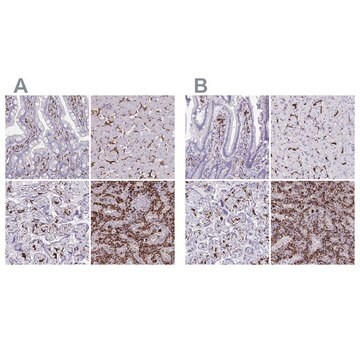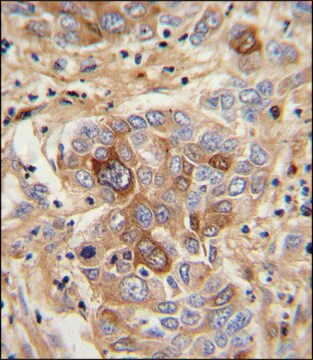Key Documents
SAB4200091
Anti-Raver1 (N-terminal) antibody produced in rabbit
~1.0 mg/mL, affinity isolated antibody
Synonim(y):
Anti-Ribonucleoprotein PTB-binding 1
About This Item
Polecane produkty
pochodzenie biologiczne
rabbit
białko sprzężone
unconjugated
forma przeciwciała
affinity isolated antibody
rodzaj przeciwciała
primary antibodies
klon
polyclonal
Postać
buffered aqueous solution
masa cząsteczkowa
antigen ~77 kDa
stężenie
~1.0 mg/mL
metody
immunoprecipitation (IP): 5-10 μg using lysates of HEK-293T cells
indirect immunofluorescence: 2-5 μg/mL using paraformaldehyde fixed HEK-293T cells
western blot: 1-2 μg/mL using lysates of K562 cells
Warunki transportu
dry ice
temp. przechowywania
−20°C
docelowa modyfikacja potranslacyjna
unmodified
informacje o genach
human ... RAVER1(125950)
mouse ... Raver1(71766)
rat ... Raver1(298705)
Opis ogólny
Specyficzność
Zastosowanie
- immunoblotting
- immunoprecipitation
- immunofluorescence
Działania biochem./fizjol.
Postać fizyczna
Przechowywanie i stabilność
Oświadczenie o zrzeczeniu się odpowiedzialności
Nie możesz znaleźć właściwego produktu?
Wypróbuj nasz Narzędzie selektora produktów.
Kod klasy składowania
10 - Combustible liquids
Temperatura zapłonu (°F)
Not applicable
Temperatura zapłonu (°C)
Not applicable
Certyfikaty analizy (CoA)
Poszukaj Certyfikaty analizy (CoA), wpisując numer partii/serii produktów. Numery serii i partii można znaleźć na etykiecie produktu po słowach „seria” lub „partia”.
Masz już ten produkt?
Dokumenty związane z niedawno zakupionymi produktami zostały zamieszczone w Bibliotece dokumentów.
Nasz zespół naukowców ma doświadczenie we wszystkich obszarach badań, w tym w naukach przyrodniczych, materiałoznawstwie, syntezie chemicznej, chromatografii, analityce i wielu innych dziedzinach.
Skontaktuj się z zespołem ds. pomocy technicznej








